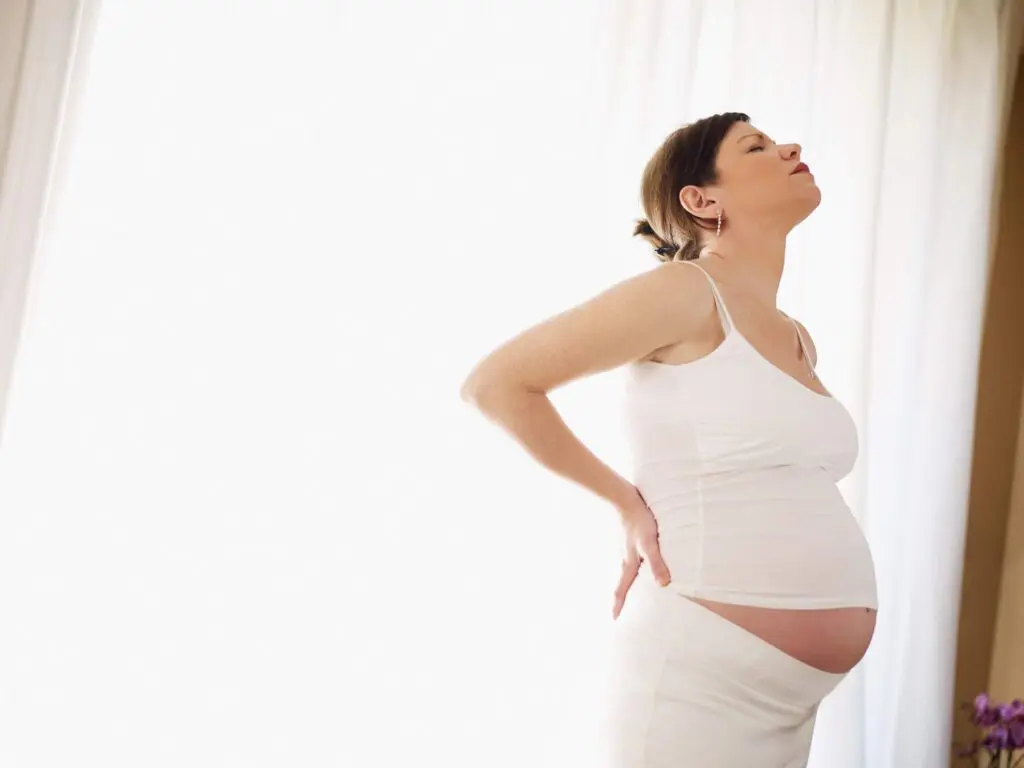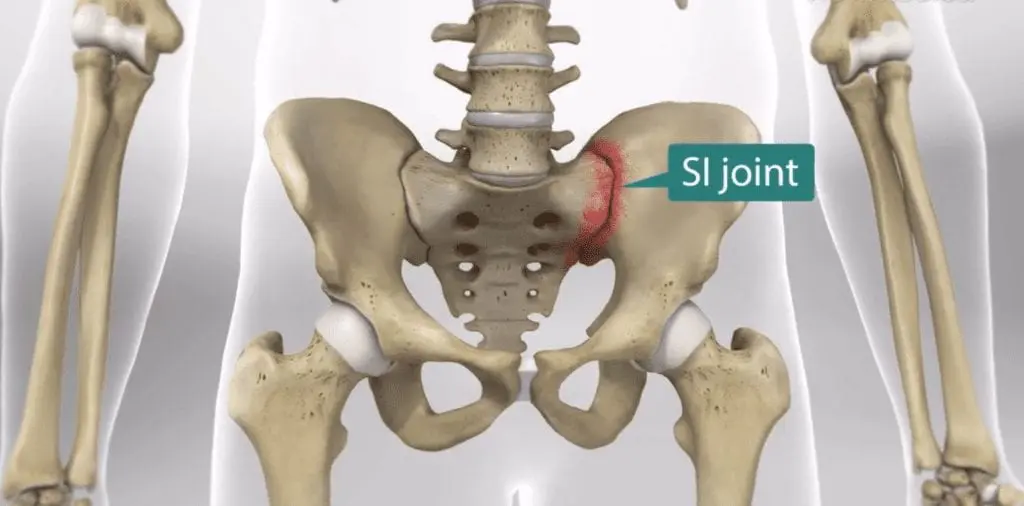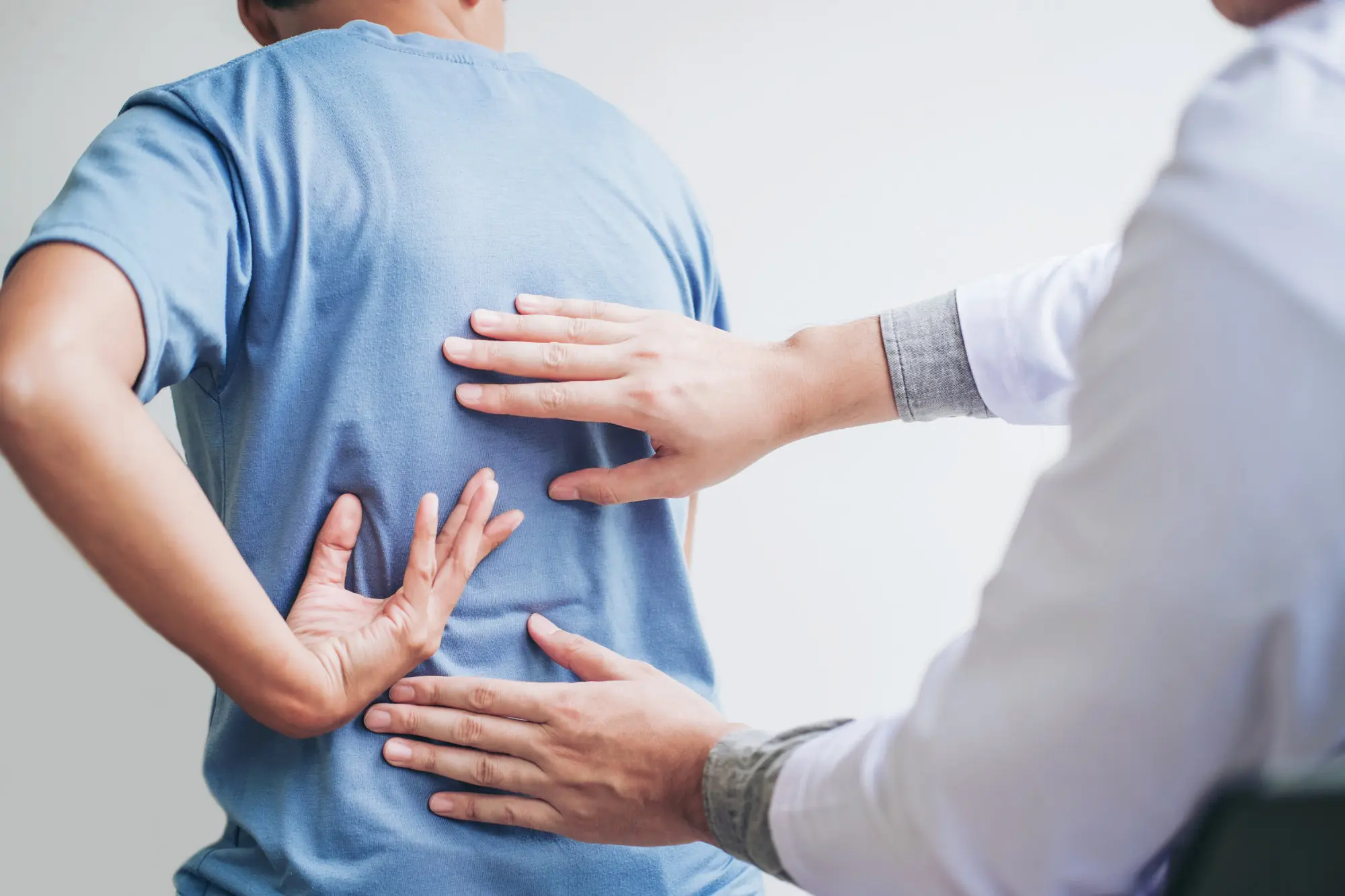
- The sacroiliac joints (SIJ) are located below the waist on both sides of the sacrum, connecting to the iliac bones via tough ligaments.
- The SIJ connects the spine to the hips and provides pelvic mobility that enables walking – chronic back pain is frequently caused by SIJ dysfunction – especially in women.
- Women are far more likely to experience SIJ Pain than men because of pregnancy. During pregnancy the body produces a hormone called relaxin – which causes ligaments and tendons to become elastic, to accommodate the baby and allow the baby to exit the pelvis.
- SIJ dysfunction after pregnancy is the leading cause of back pain in women.
- Healthy SIJ movements are incredibly small.
What Causes SIJ Pain?
- The most common cause of SIJ Pain is hypermobility (too much movement in the joint).
- When a ligament stretches, it does not regain tension. This results in loose SIJ ligaments – which can cause inflammation, pain and arthritic change (Osteoarthritis).
- Weakness in the gluteal muscles and core (transverse abdominis) can also lead to excessive motion in the SIJ – creating inflammation, pain and arthritic change.
- After pregnancy, many women suffer conditions that reduce core strength and lead to weakness in the structures that support the SIJ – which compounds the stretching of the ligaments and lead to chronic low back pain.

Book your SIJ Treatment Now
Some possible causes of SIJ pain/dysfunction are:
- Activities that involve twisting, bending, or heavy lifting
- Poor posture
- Imbalance of muscles when one leg is longer or weaker than the other
- Damage from a fall, car accident, or other injury
- Loosening of the ligaments after pregnancy and childbirth
- biomechanical causes, such as wearing a walking boot following foot/ankle surgery or non-supportive footwear, can lead to degenerative sacroiliitis.
Sacroiliac pain may resemble conditions, such as a herniated disc or hip problem. Accurate diagnosis from a myotherapist is important to determine the source of pain.
What are the symptoms of sacroiliac joint (SIJ) pain?
Sacroiliac joint (SIJ) pain ranges from mild to severe depending on the extent and cause of injury. Acute SIJ pain occurs suddenly and usually heals within several days. Chronic SIJ pain persists for more than three months. While the pain is usually one sided, it can occur on both sides and get worse with certain activities, such as sitting or walking.
Symptoms of SIJ pain may include:
- Pain and stiffness in the lower back and buttocks, that may radiate to the hips, groin, or upper thighs
- A feeling of being “out of alignment”
- Pain after sitting or standing for a long time, walking, or sleeping on the affected side
- Pain can be worse with transitional movements (going from sit to stand), standing on one leg or climbing stairs.
- Trouble bending or twisting your lower back
Reduce Your SIJ Pain at Home!
How to get rid of the SIJ and glute pain?
In most cases SIJ Pain can be treated by physical therapy, joint manipulation, anti-inflammatory medications, corticosteroid injections or prolotherapy. In rare cases surgical fusion may be recommended.
A Myotherapy treatment for SIJ dysfunction may involve:
- Strengthening of the weak stabiliser muscles
- Expert Deep tissue massage
- Dry needling and electro needling
- Low Level Laser Therapy to reduce inflammation and pain
- Joint manipulation
- Taping
What can be done to prevent the pain?
- Postural modifications and ergonomics advice
- Strengthening the pelvis using clinically proven exercises – such as McGills Big 3
- Daily walking – fast walking is usually an excellent way to reduce low back pain and inflammation
- Targeted manual therapy – deep tissue massage, dry needling and joint mobilisation
- Weight loss
- Warm-up exercises and stretching before activities to help prevent injuries.
- Learning appropriate lifting techniques (this is especially relevant for acute pain flare ups)
- In extreme circumstances cortisone injections may be used to stop the pain – but the efficacy is limited to once or twice – it stops working very quickly.
Frequently Asked Questions (FAQs)
Sacroiliac pain can mimic other conditions, such as a lower back disc herniation or hip pain. Correct diagnosis is important to determine the source of pain. Physical therapy, Myotherapy, Remedial Massage and a targeted exercise program can help to manage and prevent the symptoms.
Sacroiliac (SI) joint pain can feel similar to hip bursitis, degenerative hip disease, herniated disc, or pinched nerves. SI dysfunction symptoms commonly include low back pain, often on one side, buttock pain, sometimes pain can radiate to the hips, groin, or legs.
- Sleep on your side, affected side up
- Avoid sleeping on your stomach
- Bend one of your legs up
- Moving the painful hip backward will help you to relax
- Placing a pillow under your upper arm and a contoured cervical pillow under your head will help to keep a natural alignment of your spine
- Find the right mattress that will reduce your pain
Myofascial Dry Needling (MDN) can be used for both pain decrease and function improvement of the sacroiliac joint and hip. Pain in the SIJ and hip area usually means there’s dysfunction of the SI joint, the lumbar facet joints, muscles around the SI joint, or a combination of these symptoms.
Dry Needling or Electro Needling can be applied to the muscles around SI joint to treat myofascial trigger points (sometimes referred to as muscle ‘knots’) to reduce pain and improve the normal muscle function. MDN can also be used to treat the nerves around SIJ, which helps with pain relief around the pelvis and the hips.
Our trained Myotherapists are using advanced Dry Needling techniques for sacroiliac joint pain treatment.
Sacroiliac joint (SIJ) naturally has very limited range of motion, however, if SI joint experiences too little or too much movement or becomes inflamed, the part of the sciatic nerve that runs in front of the SIJ can get irritated. In this case pain along the sciatic nerve is caused not by a compressed nerve root in the lumbar spine, as occurs with true sciatica, but by inflammation in the sacroiliac joint. You may experience sciatic pain in the glut or along the leg due to SI joint dysfunction.
Sacroiliac joint dysfunction is one of the most common sources of pain for pregnant women. Pain can be felt at the back of your pelvis, in the hips, or refer down the legs and can get worse when you sit with your legs crossed.
During pregnancy, a hormone Relaxin makes your muscles and ligaments to relax so that the pelvis could expand as the fetus grows. When the ligaments surrounding your joints get looser, it can lead to joint instability. Increased joint mobility makes the muscles around your pelvis to compensate by tightening, which can cause pain.
In most cases sacroiliac joint pain can be fixed by nonsurgical treatments, such as physical therapy, chiropractic or osteopathic manipulation, myotherapy or remedial massage. Myotherapists at Knead Massage can use the following techniques to help get rid of your SI joint pain:
- Joint manipulation
- Various soft tissue techniques
- Dry needling and electrotherapy
- Cold Laser Therapy to reduce inflammation and pain
- Stretching and strengthening exercises
- Taping
Related Posts

Bulging Disc Brisbane

Sciatica Pain Treatments
https://www.physio-pedia.com/Pregnancy_Related_Pelvic_Pain
https://sportsmedicine.mayoclinic.org/condition/sacroiliac-joint-pain/
https://www.physio-pedia.com/Sacroiliac_Joint
https://www.fairview.org/patient-education/40548
https://abcnews.go.com/Health/CommonPainProblems/story?id=4048013
https://www.betterhealth.vic.gov.au/health/conditionsandtreatments/Back-pain</
https://www.ncbi.nlm.nih.gov/pmc/articles/PMC2582421/
https://www.ncbi.nlm.nih.gov/pmc/articles/PMC3512279/
https://www.ncbi.nlm.nih.gov/pmc/articles/PMC406328/
https://www.ncbi.nlm.nih.gov/pmc/articles/PMC6707638/
https://www.ncbi.nlm.nih.gov/pmc/articles/PMC2582421/

Liza Markova


Latest posts by Liza Markova (see all)
- Hyperkyphosis - September 19th, 2024
- Frozen Shoulder Brisbane - July 3rd, 2024
- Thoracic Outlet Syndrome Brisbane - September 27th, 2022











